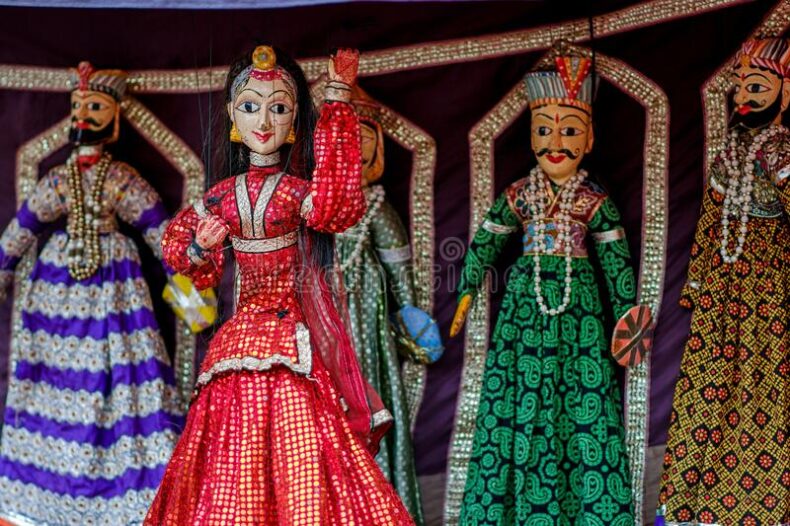India is known for its vast culture and art forms.
In India, there are more than hundreds of art forms belonging to different regions. Each and every region has its own new and unique form of art.
These art forms are a livelihood for some societies in India. In this era of modernization somewhere we found that art culture is disappearing and it is affecting the livelihood of artists. “Kathputli” is one of the art forms of folk entertainment which is also on the radar.

What is “Kathputli”?
Kathputli is a string puppet made of wood and is performed as “Kathputli nach”. In ancient India, it was the source of folk entertainment. This is a famous form of folk art rooted in Rajasthan and is the major tourist attraction there.
Generally, Kathputli has a wooden head with big eyes and a huge nose. The other body is made of lightweight colorful clothes which allows free moments. Puppets do not have legs but they are covered with long skirts. The puppets are attached with a long string from the head which is tied to the manipulator’s hand or the Kathputliwalas.
They perform different Rajasthani tales and local traditional plays. Some of the famous and necessary Kathputlis are snake charmers, stunt horse riders, and court dancers without which the show is incomplete.

Which community is dependent on Kathputli?
The main community related to Kathputhli making and performing are the Bhatta community which has been performing this art for thousands of years. These people have been connected with Rajasthani string puppetry and are carrying forward these Kathputlis as a traditional profession.

When did the story of Kathputli begin?
It is said that Kathputhli is an ancient form of art that originated around 4000 years ago. We can find puppetry art in various regions of the world like Chinese shadow puppetry. It is used to communicate the ideas and needs of human societies.
In India, we have a vast culture of Kathputhlis. In the epic Mahabharata, we can see the reference to Kathputlis. Over the years we can find its reference in Rajasthani folk songs, folk tales, and ballads. It came to India around 1500 years ago.
It is said that the first Indian ventriloquist, Professor Y.K. Padhye introduced this form of art to India, in the 1920s. His son Ramdas Padhye has popularized ventriloquism and puppetry. Works like the Natya Shastra and the Kama Sutra describe Kathputhlis in detail. Almost all types of puppets are found in India like string puppets, rod puppets, glove puppets, and shadow puppets.
As its popularity increased it was performed by many people from the Bhatta community for their livelihood and like that it has become the source of income and entertainment for them. It has become an essential part of the life of the Rajasthani people.

Themes of the Kathputli show
The themes of the Kathputhli shows were usually about the tradition of the tribal community and their lifestyle and problems. To show the nobility of the royals and the nobles the show was also themed around aristocrats. Local people like the Kathputli show because of the characters like Snake charmer, peasants, and others to which they can relate.
Daily doing things in local rural people’s life was also enjoyed by the audiences. Basically, the Kathputli Wales is from the agricultural labor community and the people saw a representation of their struggle to survive in the Kathputli shows that’s why it is more relatable. Even today, the Kathputhli shows have different stories from the Royalties to ordinary people.
Apart from only stage performance music was also one of the important aspects of Kathputli shows. The Kathputhli show is incomplete without music. Rajasthani folk music and instruments are accompanied during the show, and the Kathputhliwaala sing along.

Also Read: Glimpses of Indian Culture seen in World Dairy Conference represented in 50 countries
Why is Kathputlis dying?
There are pros and cons to everything. In this digital era where we are moving towards digitalization, it is affecting Kathputhli performance art and other forms of performing art. People today do not find Kathputhli interesting anymore because of its simplicity.
Today people prefer to watch stories of Mahabharata and Ramayana online with better transitions on an electronic medium. With the changing era social issues are also changing, so people can’t find them relatable anymore.

How are people keeping Kathputli alive?
During the immersion of new pop culture in India, Kathputhli is alive in some parts of Rajasthan with Jodhpur and Udaipur having become the bulk producer of Kathputhli. Earlier Kathputli was only seen in the Kathputhli shows and was made up of hands, but now it has become a symbol of the culture of Rajasthan all over the world. People from different areas of the world when visiting Rajasthan take a pair of Kathputhli with them and keep them as home décor.
A story that changed the medium but not the tradition
Vinay Bhaat when he was just 25 years old started a production company named Puppet Kala. This is based on the Kathputli colony in Delhi. Kathputli colony is home to myriad artists who still kept alive the traditional forms of art like puppetry, dhol, fire dance, juggling, acrobatics, traditional Rajasthani songs, kalbeliya dance, horse dance, and many other traditional art forms.
It promotes and protects the art forms as well as gives a platform to traditional talent with the help of modern touch. Vinay Bhatt has trained many national and international artists under him. His association with major puppet theaters in and outside the country brings the platform to the artists. He received Theatre and Performing Arts Fellowship in February 2020 from the Delhi Government.













